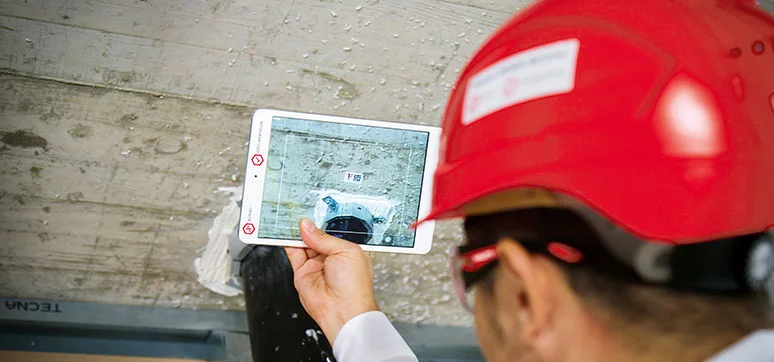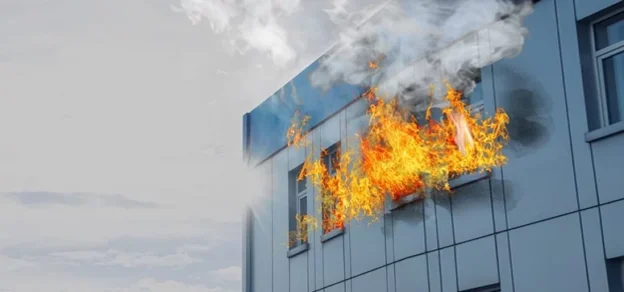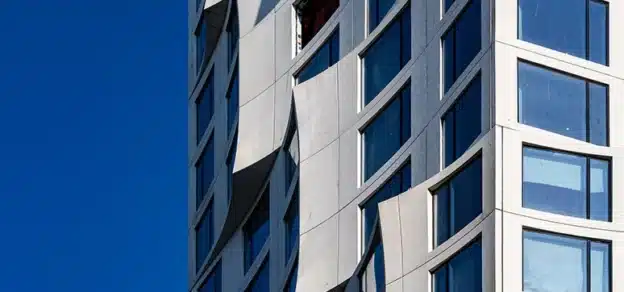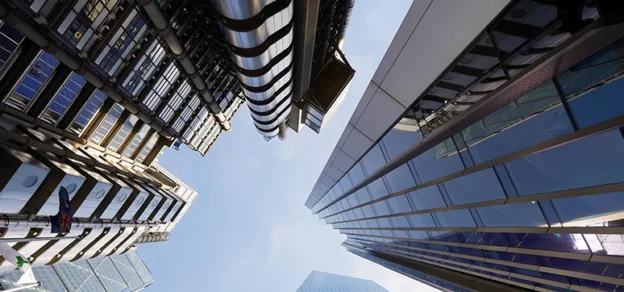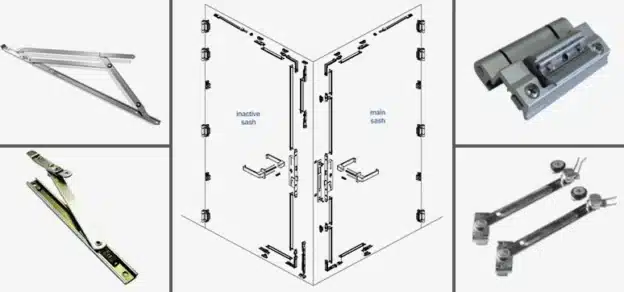A façade is the exterior wall or face of a building and glazed exterior wall assemblies, commonly referred to as curtain walls, have become a dominant feature in modern architecture. The façade is one of the most important elements of a building since it acts as the primary barrier against external weather elements such as sun, rain, wind, snow, etc.
The exterior walls are generally assembled by securing individual glass or composite panels to an arrangement of aluminium mullions and transoms. A shift from the traditional look of buildings which were built of blocks and bricks in the past, glazed façade creates a sense of modernism. Alongside the eloquent display of technology, this modernization has also witnessed several fire incidents.

Typically, the paths for the fire to spread to adjacent floor levels at the building perimeter are as below:
a) Through Void: Spreading within the building through the void space created between the edge of the floor and an exterior curtain wall.
b) Through Cavity: Spreading through a void or cavity within the exterior curtain wall. In this situation, the fire would spread by a path within the concealed space of the exterior wall.
c)Leap-frogging: Spreading to the exterior and then impinging on an opening in an upper level. This path is generally referred to as “leapfrogging”.
Amongst the various paths mentioned above, the spreading of fire within the building through the void space created between the edge of the floor and an exterior curtain wall through the ‘Chimney effect’ is quite a frequent phenomenon observed in many of the fire incidents and it can be mitigated through appropriate design, installation, maintenance and Inspection of perimeter fire barrier systems.
It’s important to recognize that the width of the horizontal gap between the slab edge and the curtain wall can vary drastically, especially considering construction tolerances in concrete buildings. Furthermore, when it is coupled with normal building deflection tolerances, creates a dilemma for builders, designers, consultants, and architects – how to provide a fire barrier that can move and flex while maintaining a seal against fire and smoke. This is when the building codes and the relevant standards play a vital role by providing guidance on the need and the importance of protecting the void between the fire-rated floor and an exterior wall in order to effectively mitigate the risk of fire and smoke propagation from one floor to another.
CODES AND STANDARDS
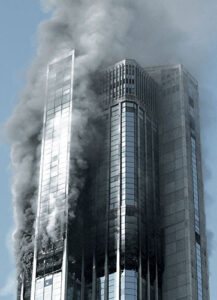
For buildings featuring glass façade assembly NBC 2016, clause 3.4.10.2 b) recommends that all gaps between floor slabs and façade assembly shall be sealed at all levels by approved fire-resistant sealant material of equal fire rating as that of the floor slab to prevent fire and smoke propagation from one floor to another. Similarly, IBC 2015, Section 715.4 states that the void created between the slab edge and the curtain wall must be sealed with an approved system tested per ASTM E2307 that remains securely in place for the time period equal to the fire-resistance rating of the floor assembly. Furthermore, NFPA 101, 2018 clause 8.3.5.4.1 mentions that the Voids created between the fire-resistance-rated floor assembly and the exterior curtain wall shall be protected with a perimeter joint system that is designed and tested in accordance with ASTM E2307, Standard Test Method for Determining Fire Resistance of Perimeter Fire Barriers Using Intermediate-Scale, Multistory Apparatus.
In general, any void between the fire-rated floor and an exterior wall must be protected using a perimeter fire containment system that has been tested in accordance with ASTM E 2307 standard that provides an ‘F-rating’ that is equal or greater than the fire-resistance rating of the floor. The ASTM E2307 test is titled the ‘Standard Test Method for Determining Fire Resistance of Perimeter Fire Barriers Using Intermediate-Scale, Multistory Test Apparatus’.
TESTING AND RATING
The basic configuration of the test furnace and test sample in ASTM E 2307 includes a two-story building with the test room on the first floor fully engaged in a post-flashover fire condition. The fire is provided using two burners, one internal burner placed inside the structure and one external burner placed outside the structure, providing a flame plume up along the side of the building. An exterior curtain wall is then installed on one side of the structure. The void between the curtain wall and the edge of the floor slab is then protected with materials that are intended to prevent the passage of flames through the void.
To be considered a dynamic perimeter joint protection, both expansion/ contraction and shear movements must be cyclic tested. The cyclic movement demonstrates the perimeter joint protection’s ability to move in expansion/contraction responding to environmental forces (wind, thermal, and seismic) and to move in shear in reacting to live loads while maintaining a seal between the floor assembly and exterior wall assembly and resisting fatigue and degradation. The cyclic rate, magnitude, and duration of movement can also affect the performance of the perimeter joint protection when subjected to standardized fire exposure and ASTM E2307 provides test conditions for these variables.
When field conditions differ from the original design or unanticipated construction hindrances are encountered, Engineering Judgments (EJ’s) are typically made that recommend alternative methods to ensure the performance of the firestop system is not compromised.
Generally, these conditions or hindrances cannot be easily or cost-effectively redesigned so alternative protection schemes must be implemented to maintain the system’s integrity. Since these recommendations are to be based upon identical designs as those which were fire tested, it is important that they be developed using sound engineering principles and have to be provided by trained and qualified personnel based on the recommendations prescribed in IFC guidelines.

SYSTEM SELECTION
In order to choose the right system, it is important to know the basic details of the application such as the is the makeup of the exterior wall – spandrel glass, aluminum panel, etc., hourly rating, joint width, static or dynamic joint, etc.
The right system selection for the perimeter firestop system can be done by accessing third-party certification laboratory listing directories. One of the examples is the Intertek certification directory. The Intertek directory follows a specific nomenclature to identify the different firestop systems listed based on which right system can be chosen to suit the specific needs of the project.
INSTALLATION, INSPECTION & MAINTENANCE
A firestop system must be properly installed to be effective and hence it needs to be installed by a trained and qualified installer. Since the perimeter fire barrier system is a ‘Listed’ system, it must be installed in accordance with their listing and the manufacturer’s installation instructions. Typically, firestop manufacturers will have their own programs and qualification criteria for installers wherein they educate and train them on the trade-specific installation methodologies
W.r.t Inspections, NBC 2016 requires fire safety audits to be conducted at least once in two years. Code users may want to be aware of the ASTM E 2393 standard, Standard Practice for On-Site Inspection of Installed Fire-resistive Joint Systems and Perimeter Fire Barriers.
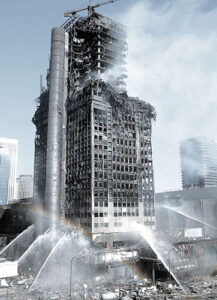
Typical points that are considered for inspection of the perimeter fire barrier system include the following aspects:
• Is the rating of the perimeter fire barrier system equal to or greater than the floor it is adjacent to?
• Is the EOS joint system tested and listed by an accredited lab?
• Is EJ made available in case of non-availability of the tested system exactly matching the actual site condition
• Does the field installation follow the listing w.r.t width of the gap between floor edge and curtain wall, curtain wall spandrel insulation (type, thickness, density, etc.), saving insulation (type, depth, % of compression), etc
For speciality Firestop contractors and special inspection agencies conducting speciality firestop inspections, the ULULC qualified contractor, FM 4991 approved and IAS AC 291 programs are credible 3rd-party accreditation programs.
Per IFC 2015, clause 703.1, Maintenance – The required fire-resistance rating of fire-resistance-rated construction, including, but not limited to, walls, firestops, shaft enclosures, partitions, smoke barriers, floors, fire-resistive coatings, and sprayed fire-resistant materials applied to structural members and fire-resistant joint systems, shall be maintained.
Such elements shall be visually inspected by the owner annually and properly repaired, restored, or replaced where damaged, altered, breached, or penetrated. Records of inspections and repairs shall be maintained.
CONCLUSION
The use of a tested and listed perimeter firestop system is required by the ‘Building and Life safety codes in order to contain the fire and smoke in place of its origin and the absence of such a system in buildings may turn a simple fire incident into a catastrophic inferno. It is important to have the right ‘Firestop System’ designed and installed by trained and qualified personnel. Furthermore, the national and international building codes also mandate proper documentation and periodic inspection of ‘Firestop systems. Adherence to code requirements ensures safety and peace of mind for the builders, contractors, architects, inspectors, and occupants. In addition, it helps the firefighters to carry out firefighting and rescue operations thereby enabling them to save lives and protect assets.
